- Muncly Salesforce Consultancy
- Automotive
- Salesforce Automotive Cloud Ultimate Guide with Insider Tips
Salesforce Automotive Cloud Ultimate Guide with Insider Tips
- Jeff Tilley
- July 24, 2023
- Automotive

Table of Contents
About the Guide
Welcome to our Ultimate Guide to Salesforce Automotive Cloud! Whether you’re a curious newcomer exploring sales and automotive cloud solutions, or a seasoned Salesforce expert looking to expand your knowledge, this guide is tailored for you. Join us as we delve into the world of Salesforce Automotive Cloud, launched on October 13th, 2022. Designed to meet the unique needs of the automotive sector, this platform is a key player in managing inventory and customer demands. We’re excited to share insights and insider tips, helping you navigate through this digital transformation journey in the automotive industry. Let’s begin!

You see, we too were once in your shoes, struggling to sift through all the information about this new era fresh-off-the-oven Salesforce industry cloud. And boy, did we wish for a guide like this! So we took matters into our own hands and created this gem, which we ourselves use quite a lot, ensuring it stays up-to-date.
You’ll get insider access to insights from those exclusive, invite-only Salesforce events, with sneak peeks to gain insights into the roadmap ideas Salesforce is juggling with and the features they’re highlighting. But there’s more – we’ve also hunted down some fantastic resources outside the Salesforce sphere that’ll be a great help with the Salesforce Automotive Cloud. Our passion is all about smoothing this digital transformation journey for you, customer experiences, the way we wish someone had done for us!
This handy guide is designed for both curious customers delving into the world of sales and automotive cloud and their companies, seasoned Salesforce experts, automotive companies and customers looking to broaden their horizons with other cloud platforms. We’re here to support your sales process research and learning journey, making the process as easy as possible for you.
Automotive Cloud
Salesforce Automotive Cloud, announced by Salesforce on October 13th, 2022, represents the company’s ongoing commitment to delivering targeted, industry-specific cloud solutions. This particular platform plays a crucial role as it’s uniquely designed to address specific needs and challenges within the automotive sector, helping organizations manage inventory location and meet customer demands. By utilizing the innovative features of this cloud based platform, organizations can streamline operations, improve customer relations, manage data more effectively.
The Salesforce Automotive Cloud signifies an important evolution in how technology can be harnessed to improve industry-specific operations, and we’ll examine its particular functionalities and benefits in the upcoming sections.
What is Automotive Cloud
After weeks of studying Automotive Cloud, visiting invite-only events online marketplace and even producing a few Proof-of-Concept projects, we concluded that it will be best performing in the following use cases:
- Automakers (OEM – Original Equipment Manufacturers)
- Importers
- Distributors
- Automotive finance group (make sure to check out what we know about the roadmap)
What Automotive Cloud is NOT
Even though there are always exclusions to the rules, we believe it is NOT:
- DMS (Dealership Management System)
- ERP system (Enterprise Resources Planning)
- Manufacturing Planning system
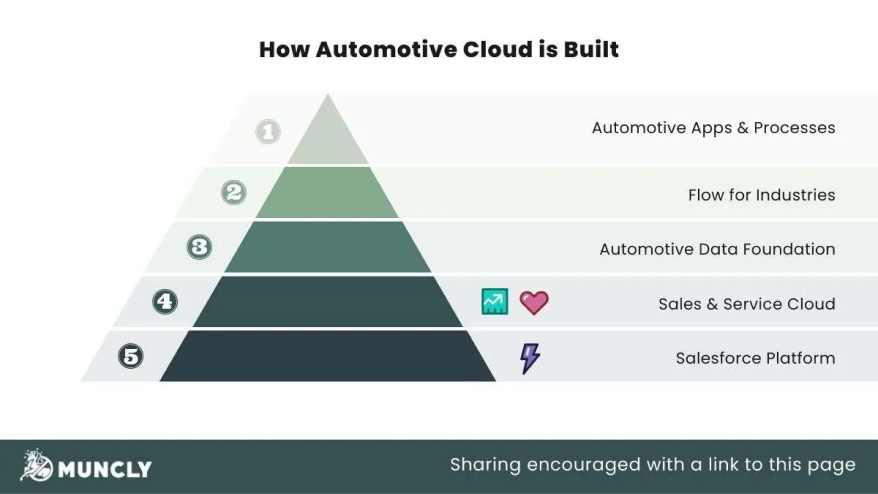
Automotive Cloud, at its core, is a Salesforce Platform + Sales & Service cloud-based solution, topped up with the automotive ecosystem and industry-specific customizations (Salesforce claims STAR data model usage, but we would take this with a grain of salt). Additionally, Salesforce added a plethora of declarative (no-code) tools from Manufacturing Cloud, that enables companies for automotive solutions as a low-maintenance solution. We will talk about Manufacturing Cloud a lot since Salesforce is basing Automotive + Cloud based platform on that solution (or better to say, took Manufacturing Cloud as a starting point).
Discover the future of mobility with our groundbreaking book
Offering an unparalleled journey through the evolution of the automotive industry

High Level Capability Overview
We’ve rolled up our sleeves and gathered all the key capabilities – not just the ones Salesforce is highlighting, but also a few cool capabilities that we think are pretty nifty. We’ll go into more detail later, but don’t worry if you’re not a Salesforce pro. This quick overview should give you a pretty good feel for what this new Cloud can do for the automotive industry. Buckle up, and let’s hit the road!
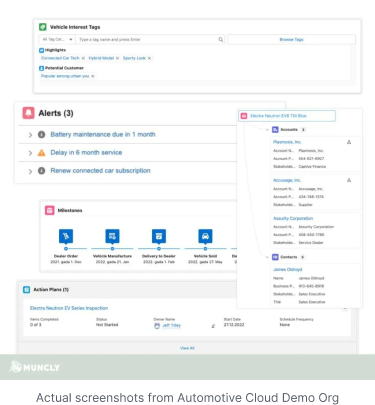
Driver Console
Similar to Vehicle Console, Driver Console allows displaying related data around owner of the car and customer behavior. Or, more correctly, driver and customer data. After taking a closer look, it appear that Salesforce Automotive Cloud is packed with some additional features on the Opportunity level, plus contains Automotive data model.
Vehicle Console
Similar to Vehicle Console, Driver Console allows displaying related data around owner of the car and customer behavior. Or, more correctly, driver and customer data. After taking a closer look, it appear that Salesforce Automotive Cloud is packed with some additional features on the Opportunity level, plus contains Automotive data model.
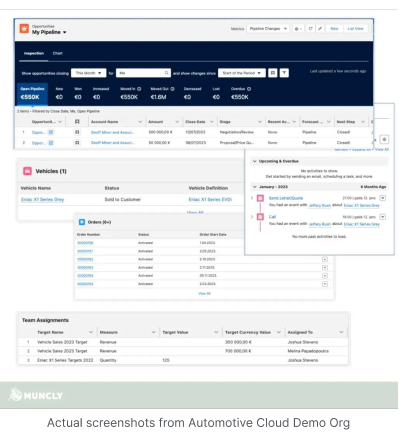
You might already be familiar with the feature called Household Management if you know automotive companies who’ve used other Salesforce platforms. It’s been handy for automotive companies in various clouds, ranging from Retail experiences to Non-Profit. Essentially, this tool equips automotive companies with a flexible data sharing structure unified customer, and certain features that make it easier to keep track of customer interactions with multiple individuals from the same family or, more accurately, the same household.
Shifting gears to the all-important matter of vehicle data management, let’s talk about the Automotive Data Foundation. Salesforce says they’ve drawn inspiration from the STAR (Standard In Automotive Retail) standard for their vehicle data model. Upon closer inspection, it seems like Salesforce has given it their own unique spin rather than adopting it outright. Regardless, the familiarity of the data model is a huge plus, making it feel like we’ve already got a foot on the gas pedal towards a more efficient future.
When it comes to Lead Management, the Automotive Cloud goes a few steps further than the standard Salesforce Sales Cloud. In addition to the basic foundation it inherits from Salesforce, the Automotive edition includes Products, Preferred Seller, Action Plans, and even the ability to link one automotive lead management name to one or more other partners with multiple vehicles of interest. These enhancements hint at a lead management system specially designed for organizations dealing with multiple sellers launch partners, or distributors. So if you’re a manufacturer, distributor, or large importer, it seems Salesforce had you in mind when they revved up this feature.
Now, let’s get to the really juicy bit. Salesforce has released what they’re calling a “tailored for automotive Experience Cloud”. It’s a bit of a half-and-half situation. They’ve added a couple of extra objects, which, to be honest, would be accessible anyway with Platform Licenses (let’s park the discussion on licensing for now, it’s a winding road!). After taking it for a spin, we found out that it’s essentially a salesforce Partner Portal template, fine-tuned for lead distribution and opportunity tracking for retail partners (pretty much for dealers). It’s a pretty slick addition if it syncs well with your business model.
Ever taken a peek at Salesforce forecasting? Well, the Salesforce Automotive Cloud has a fresh take on this. They’ve decked out the forecasting functionality, likely with manufacturers in mind (we’re honestly scratching our heads a bit to figure out who else might use this specific feature). Generally, it’s ERP systems that handle these kinds of data tables. But Salesforce is quick to clarify they’re not trying to race against ERPs. Their angle? They’re focusing on future sales projections instead of past performance. A pretty interesting turn, don’t you think?
Buckle up, because the Rebates feature is quite the ride. It’s a biggie and particularly pertinent to the automotive industry, deserving an article all of its own. But hold on, there’s a bit of a terminology twist. You see, in most automotive circles, what Salesforce calls ‘rebates’ are usually termed ‘campaigns’. So, if you’re new to the Salesforce universe, this might throw you off track a little. But here’s the silver lining – Salesforce includes a super handy business rule engine for rebate approvals. This could be a real game-changer, especially when dealing with a high volume of rebates, or ‘campaigns’ as we’re more accustomed to calling them in the automotive industry.
Interestingly, one element that seems to have taken the back seat in Salesforce’s promotional materials, yet definitely warrants your attention, is their warranty management feature. This function offers a comprehensive and powerful solution for handling warranties in the automotive industry, a sector where warranty claims and the customer experiences, customer loyalty and service are closely linked. Even though it’s not the star of the show in Salesforce’s communication, this feature is actually a hidden gem. It’s been fine-tuned to track warranty details, streamline claim processes, and facilitate better customer relations, all crucial in today’s competitive automotive landscape. So while Salesforce might not be shining a spotlight on it, we believe the warranty management feature is truly an unsung hero that deserves recognition in their suite of offerings.
Along with Manufacturing Cloud, Salesforce automotive service cloud comes with, what used to be called Tableau CRM now called CRM Analytics with pretty nice prebuilt dashboards. We always loved Tableau and it’s design, even when it’s a bit out of place, this tools enables companies and automotive companies to build really sophisticated reports from data available on the Salesforce platform. This is especially handy, if you are looking to shift most of your IT operations to Salesforce, but still have to keep some legacy systems. These licenses will allow you to integrate third party data sources and access report and dashboard straight from your automotive service cloud.
Industry Cloud
So here’s an interesting backstory – Salesforce’s Automotive Cloud service is actually built on their Industry Cloud service, which has its roots in a company called Vlocity. Salesforce liked what Vlocity was doing so much, they bought the company, integrated it into their ecosystem, and voila, the Industry Cloud service was born. To be honest, we think it’s one of Salesforce’s best acquisitions to date, and they’ve done a top-notch job of integrating the functionalities into their platform for customers.
Now, why should the automotive world care? It all boils down to one magic word – administration. The beauty of the Industry Cloud is that many of its key features, are “declarative” – meaning they don’t need custom code and can be managed by folks who aren’t necessarily coding wizards. This translates into better understanding of customer demands, lower costs and better scalability, a win-win for any business.
Alright, let’s kick things into gear and start exploring these features one by one.
Discover the future of mobility with our groundbreaking book
Offering an unparalleled journey through the evolution of the automotive industry

If you’re a fan of customization without coding, you’re going to love OmniStudio. It’s a toolbox filled with Salesforce customization goodies that does two key things. First up, it lets you whip up custom screens without having to write a single line of code, thanks to a neat feature called FlexCards. Then there’s Data Raptors, a cool tool that lets you weave in data from across your entire system right into those screens.
But that’s just scratching the surface of what OmniStudio can do. If you’re eager to learn more and dive deeper, we’d recommend checking out the datasheet. Here’s the link to the original document.
Generating PDFs has been a topic of heated debate for decades and, believe it or not, it still is. For your everyday use, this might seem like a pretty routine task. But here’s the kicker: PDFs are actually complex files that demand sophisticated algorithms to create. Salesforce Automotive Cloud has a built-in solution for generating PDFs. We haven’t had the chance to really put it to the test yet, but it’s certainly a feature worth noting.
Decision tables are all about applying complex business rules. We won’t delve too deeply into this feature here, but what you need to know is this: it’s a powerful tool for automating your decision-making and sales process. For example, you can set up intricate criteria for approving rebates or discounts, saving you the trouble of approving quotes manually. But this is just one use case—there’s so much more this feature can do.
Most of us are familiar with OCR technology, the old-school method of converting paper documents into digital data. Well, Salesforce Automotive Cloud has an intelligent document reader that transforms those paper documents into Salesforce records. You can then create business rules for these records, report on them, or simply store them for future reference.
Much like decision tables, the business rules engine is all about automating decisions and customer engagement. Depending on the rules you define, this engine assists with eligibility informed decisions and customer interactions. In the past, ERP systems handled much of this kind of work, but it’s exciting to see this feature making its way into the world of CRM.
For the typical business user, explaining the Data Processing Engine (DPE) might be a bit complex. But think of it like this: you have data from multiple systems, all in different formats and locations. The DPE merges this data into a single Salesforce record, making it easier to digest and action upon. It also allows for complex rollups, providing you with actionable insights.

Features that caught our attention
We’ve also noted some unique features during Salesforce’s demos and exploration of Automotive Cloud. Remember, we’re not trying to list all the features here—that would make this article way longer. We’re focusing on the ones we found particularly useful and relevant to many implementations of automotive solutions.
Alerts
Alerts are unique pop-up notifications that appear at the Vehicle level. They notify you about different events related to a Vehicle, such as upcoming maintenance or warranty expiration. (see screenshot below)
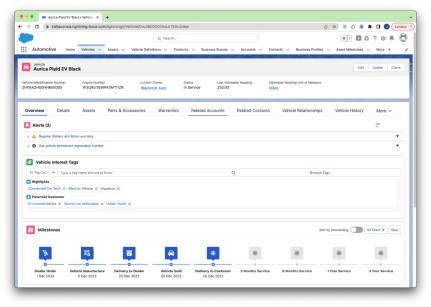
Vehicle Interest Tags
Interest tags are simple, reportable tags linking interests to vehicle properties. Though seemingly simple, they could offer significant value. For example, they can match complex vehicle features with simple, user-friendly tags, streamlining the customer unified experiences.
Vehicle Milestones
Next up, let’s talk about Vehicle Milestones, or as Salesforce technically labels them, Asset Milestones (though that name might throw you for a loop). This feature is all about tracking events of connected vehicles, which, let’s face it, don’t always happen in the order we expect.
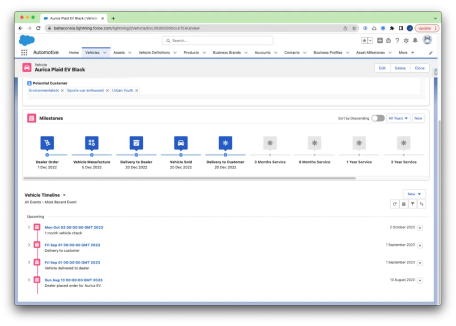
Next up, let’s talk about Vehicle Milestones, or as Salesforce technically labels them, Asset Milestones (though that name might throw you for a loop). This feature is all about tracking events of connected vehicles, which, let’s face it, don’t always happen in the order we expect.
Salesforce typically offers a feature known as ‘Path’ for tracking status, but to be frank, Path is really just a list of different statuses. The Vehicle Milestones, on the other hand, offers a different approach. Although it might look similar to Path at first glance, it’s actually quite different. It accommodates multiple events of the same type and lays out events (like manufacturing, sale, or warranty expiration) in a way that’s super easy to understand. This makes Vehicle Milestones not just useful, but user-friendly too.
Discover the future of mobility with our groundbreaking book
Offering an unparalleled journey through the evolution of the automotive industry

Vehicle Timeline
Vehicle Timeline is akin to Vehicle Milestones, offering an alternative method to visualize the same information. All the events tied to a vehicle history are showcased in a linear, timeline format, which greatly simplifies the process of monitoring a vehicle’s status and the vehicles history itself. It presents a clear and easily digestible record of connected vehicles, past, present, and upcoming events related to the vehicle.
Licensing
Licensing model for Salesforce Automotive Cloud, at first, looks very straight forward. 300 to 400 USD (or EUR) per user per month. And it also looks very expensive to a business user, who never worked with the Salesforce automotive cloud ecosystem and doesn’t know insights on how to license salesforce, however, here’s what you need to know about Salesforce licensing.
You don’t need full license for all your users. You have two options
- Automakers (OEM – Original Equipment Manufacturers)
- Importers
- Distributors
- Automotive finance group (make sure to check out what we know about the roadmap)
Resources
- All
- For Customers
- For Partners

Schedule a Demo and let us guide you through the new cloud.

Limited in information, but always up to date.

A useful all-around resource to get you started.

Your go-to place to get your development org.

A go to place for technical details, setup and implementation

A very handy documents for pre-sales and to answer complex questions from customers

For those who have access to Salesforce Partner community.

Watch Automotive Cloud keynote from Salesforce.


















